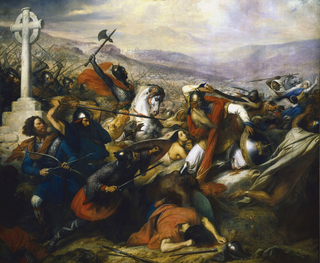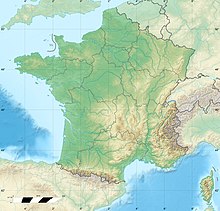The 430s decade ran from January 1, 430, to December 31, 439.

Year 439 (CDXXXIX) was a common year starting on Sunday of the Julian calendar. At the time, it was known as the Year of the Consulship of Theodosius and Festus. The denomination 439 for this year has been used since the early medieval period, when the Anno Domini calendar era became the prevalent method in Europe for naming years.

Aetius was a Roman general and statesman of the closing period of the Western Roman Empire. He was a military commander and the most influential man in the Empire for two decades (433–454). He managed policy in regard to the attacks of barbarian federates settled throughout the West. Notably, he mustered a large Roman and allied (foederati) army in the Battle of the Catalaunian Plains, ending a devastating invasion of Gaul by Attila in 451, though the Hun and his subjugated allies still managed to invade Italy the following year, an incursion best remembered for the ruthless Sack of Aquileia and the intercession of Pope Leo I.

Athaulf was king of the Visigoths from 411 to 415. During his reign, he transformed the Visigothic state from a tribal kingdom to a major political power of Late Antiquity.

The County of Toulouse was a territory in southern France consisting of the city of Toulouse and its environs, ruled by the Count of Toulouse from the late 9th century until the late 13th century.

Septimania is a historical region in modern-day southern France. It referred to the western part of the Roman province of Gallia Narbonensis that passed to the control of the Visigoths in 462, when Septimania was ceded to their king, Theodoric II. During the Early Middle Ages, the region was variously known as Gallia Narbonensis, Gallia, or Narbonensis. The territory of Septimania roughly corresponds with the modern French former administrative region of Languedoc-Roussillon that merged into the new administrative region of Occitanie. In the Visigothic Kingdom, which became centred on Toledo by the end of the reign of Leovigild, Septimania was both an administrative province of the central royal government and an ecclesiastical province whose metropolitan was the Archbishop of Narbonne. Originally, the Goths may have maintained their hold on the Albigeois, but if so it was conquered by the time of Chilperic I. There is archaeological evidence that some enclaves of Visigothic population remained in Frankish Gaul, near the Septimanian border, after 507.
The history of Toulouse, in Occitania, southern France, traces back to ancient times. After Roman rule, the city was ruled by the Visigoths and Merovingian and Carolingian Franks. Capital of the County of Toulouse during the Middle Ages, today it is the capital of the Midi-Pyrénées region.
Al-Samh ibn Malik al-Khawlani was the Arab governor general of Al-Andalus from between 719 and 721. In 720, under his governorate he minted the first purely Arab coins in Al-Andalus as part of his fiscal reforms.
The siege of Narbonne was fought in 737 between the Arab and Berber Muslim forces of Yusuf ibn Abd al-Rahman al-Fihri, Arab Umayyad Muslim governor of Septimania on behalf of al-Andalus, and the Frankish Christian army led by the Carolingian duke Charles Martel.
The Battle of the River Berre was fought in 737 between the Arab and Berber Muslim forces of Yusuf ibn Abd al-Rahman al-Fihri, Arab Umayyad Muslim governor of Septimania on behalf of al-Andalus, and the Frankish Christian army led by the Carolingian duke Charles Martel during the siege of Narbonne. The battle, which took place at the mouth of the River Berre, was a significant victory for Charles Martel in the military campaigns of 736–737. During this period, Martel effectively prevented greater Umayyad expansion beyond the Pyrénées.
Battle of Narbonne may refer to:

Capestang is a commune in the Hérault department in southern France.

Theodoric I was the King of the Visigoths from 418 to 451. Theodoric is famous for his part in stopping Attila the Hun at the Battle of the Catalaunian Plains in 451, where he was killed.

The Umayyad invasion of Gaul occurred in two phases in 719 and 732 AD. Although the Umayyads secured control of Septimania, their incursions beyond this into the Loire and Rhône valleys failed. By 759 Muslim forces had lost Septimania to the Christian Franks and retreated to Iberia.

The siege of Narbonne took place in France between 752 and 759, led by the Frankish king Pepin the Short against the Umayyad stronghold defended by an garrison of Arab and Berber Muslim troops who had invaded Septimania and occupied the Visigothic Kingdom and its Gallo-Roman inhabitants since 719. The siege remained as a key battlefield in the context of the Carolingian expedition south to Provence and Septimania starting in 752.
Litorius was a Roman general of the closing period of the Western Roman Empire serving as Magister militum per Gallias mainly in Gaul under magister militum Flavius Aetius. Litorius is noted for being the last Roman commander in the ancient Roman military history to perform pagan rites and the consultation of auspices before a battle.
The Battle of Toulouse was fought between the Visigoths and the Western Roman Empire in 439. Having previously defeated the Visigoths at Narbonne, the Roman general Litorius led his largely Hunnic army against Toulouse, the capital of the Visigothic Kingdom. During the siege, the Visigothic king Theodoric I attacked the Roman camp and inflicted heavy casualties. Litorius was captured and executed. Since the Visigoths also suffered heavy losses, Theodoric made peace with the Roman governor Avitus.

The Burgundian Revolt of Gunther consisted two revolts of the Burgundian foederati in the Western Roman Empire during the reign of Emperor Valentinian III. The uprisings happened in the Gallic province of Germania Prima and was led by the King of the Burgundian Gunther, his main opponent was General Aetius.

The Gothic War (436-439) was a military conflict between the Gothic foederati and the Western Roman Empire under Emperor Valentinian III. It occurred primarily in the Gallic provinces from 436 to 439. The key figures involved were the Gothic leader Theodoric I and the Roman army's commander-in-chief, Aetius. Contemporary sources characterize this conflict as a war. Additionally, there were uprisings of the Burgundians and the Bagaudae during the same period.
The Battle of Mons Colubrarius was a battle in the Gothic War from 436 to 439. It was one of the many armed conflicts between the Gothic people and the Western Roman Empire during the first half of the fifth century. The main protagonists in the war were the Visigothic king Theodoric I and the commander-in-chief of the Western army General Aetius. The battle probably was fought near the French village Olonzac around 438.












